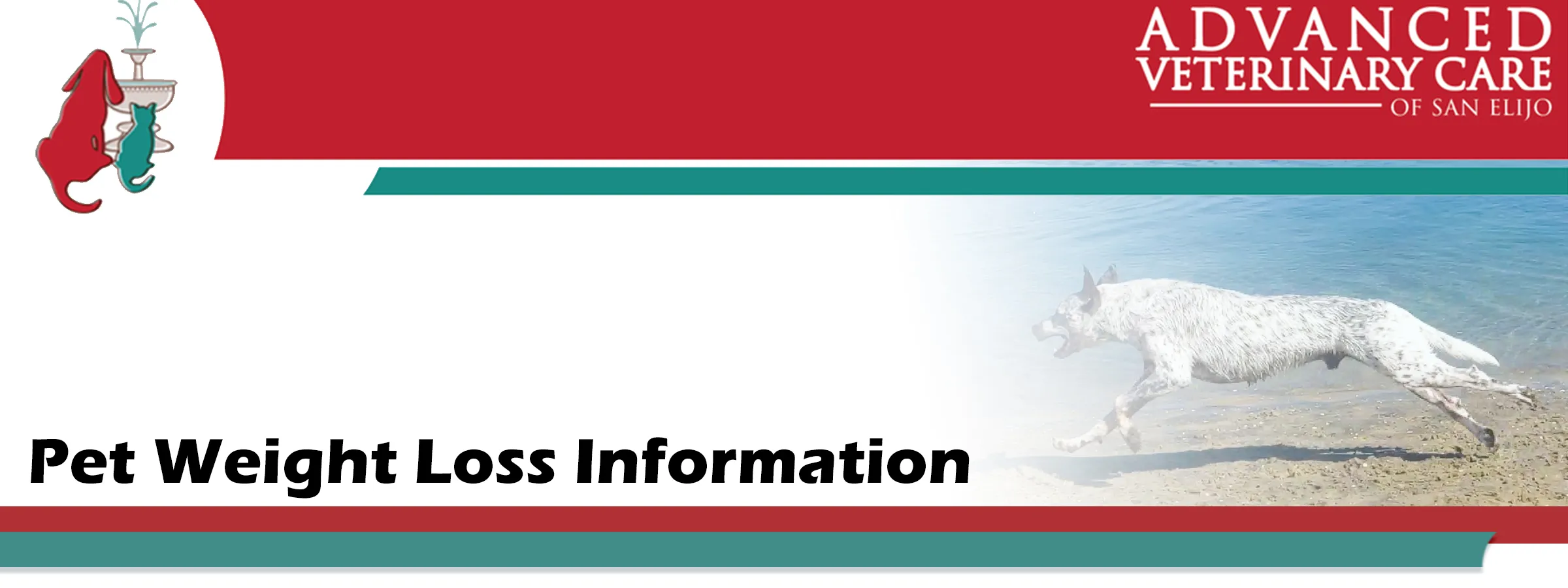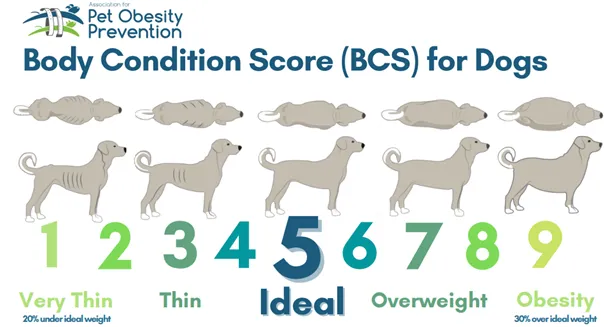Healthy weight is an important component of wellness in both pets and people. For pets, even a few pounds over their “ideal” weight can put them at risk of a multitude of medical problems. Many of these medical issues can significantly affect your pet’s general wellness; some can even shorten your pet’s life.
Many studies have shown excess weight to be associated with a range of health conditions. Common weight-related disorders include:
- Musculoskeletal conditions including: Osteoarthritis, cranial cruciate ligament injuries, strains, sprains, and decreased mobility
- Luxating patella due to cartilage damage
- Heart disease
- Respiratory conditions
- High blood pressure
- Type 2 diabetes
- Chronic inflammation
- Worsening allergies (secondary to chronic inflammation)
- Kidney disease
- Certain cancers
Studies have shown that pets who are at or just below ideal body weight on average live significantly longer and have a better quality of life.
Assessing Your Pet’s Body Condition
Talk to Your Veterinarian: Your veterinarian is best able to assess if your pet is overweight. At your pet’s annual or biannual (for seniors) exam, your veterinarian will be able to assess your pet’s weight and discuss any recommendations for weight loss (or gain) if recommended.
Feel the Ribs: Dogs and Cats hold excess fat over their ribcage. As a result, one of the simplest ways to monitor your pet’s weight is feeling their ribs. You should be easily able to feel your dog or cat’s ribs when you gently run your fingers along their ribcage. If you have to push to find them, it means your pet has a significant layer of fat over their ribs and is likely overweight. Dogs and cats should have no more than a thin layer of fat over their ribs to be considered a “healthy weight.”
Look at Their Waist: If you look at your pet from above, they should have a visible waistline behind their ribcage. While dogs can have very different shapes, all dogs should have some kind of a taper behind their ribcage with an indentation halfway between the ribs and the hips. If your pet does not have a taper, or has a bulge, they may be overweight.
Look for a “Tummy Tuck”: Look at your pet from the side. If their abdomen hangs low or appears bulging or sagging, they may be overweight. *A significant roundness or hanging of the belly, especially one that comes on suddenly or is in absence of your pet being significantly overweight, can indicate a medical condition and should be address by a veterinarian.
Helping your Pet Lose Weight
Rule out underlying medical concerns: If your pet is overweight, start by discussing the concern with your veterinarian. There are medical problems which can lead to excess weight and these should be ruled out before starting a weight loss program.
Determine your pet’s ideal weight: Work with your veterinarian to determine your pet’s “ideal” weight, so that you have a goal to reach for.
Realistically measure your pet’s food volume, including treats: Spend a day or so accurately logging what your pet eats. If you normally ration your pet’s food out using glasses, mugs, drinking cups, or “handfuls,” determine what that volume is using measuring cups. This will allow you to decrease your pet’s food intake.
Eliminate excess caloric treats: It is recommended that you reduce the number of calorically dense treats your pet consumes. These can be replaced with low calorie, healthy treats. For dogs, these include carrots, sliced cucumbers, and green beans
Change your pet’s food volume: Weight loss will be nearly impossible without some form of calorie reduction. Many people feed their pets based on instructions on the food bag. Unfortunately, these tend to wildly overestimate an average pet’s caloric need, so it should not be used as a hard and fast rule for your own pet’s food volume.
If using your pet’s diet: Decrease Your Pets Food Volume by 25%: For moderately overweight pets, you can start helping them lose weight by simply decreasing the volume of food that they are given. A healthy rule is to decrease their intake by 25% (1/4 of their current volume) then weigh the pet in a month to gauge efficacy. Do not decrease your pet’s food volume by more than 25% without consulting a veterinarian. Decreasing volume also decreases the nutrients that your pet is taking in. Decreasing your pet’s food volume too much (or feeding more treats than food) and result in poor nutrition.
Using prescription therapeutic weight loss diet: For real weight loss, it is hard to beat the efficacy of Prescription therapeutic diets. These diets are formulated to allow you to feed the correct volume for weight loss without compromising nutritional content such as vitamins, minerals, micronutrients, and macronutrients. Additionally, they are formulated to help your pet feel satiated as they lose weight.
Feed smaller, more frequent meals: Spread your pet’s total food volume into several meals throughout the day instead of one large one. This spreads out calorie intake, allowing your pet to utilize their calories more effectively. It also increased their general sense of satiety and reduces begging.
Engage your pet in exercise: Assuming your pet has no conditions that require exercise restriction, exercise/actively play with your pet for 30 minutes a day. If your pet is highly sedentary, start with very slow, easy sessions and slowly increase activity over the weeks.
Weigh your pet monthly: weigh your pet once a month on an accurate scale (we are happy to have you weigh your pet here!). This allows you to monitor progress and make adjustments as necessary. Report our weight loss to us so we can help monitor your dog’s progress and recommend changes, if necessary.
Be patient: Safe weight loss is typically only 3-5% of of pet’s current body weight per month. This means that a 10lb pet would only lose at maximum ½ lb, while a pet weighing 100lbs would lose 3-5lbs. Regular weigh-ins can help ensure that your pet is losing weight and does not need any adjustments to their plan.
If you have any concerns about your pet’s weight or on your pet’s weight loss journey, do not hesitate to contact our hospital.
Appendix: Body Condition Scoring
Graphics courtesy of the Association for Pet Obesity Prevention



